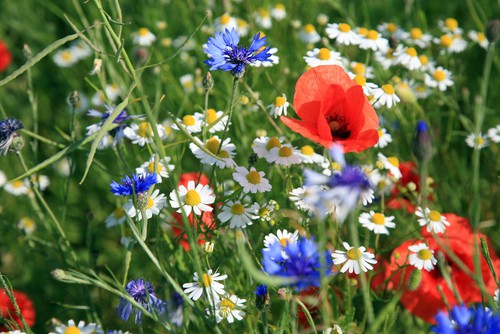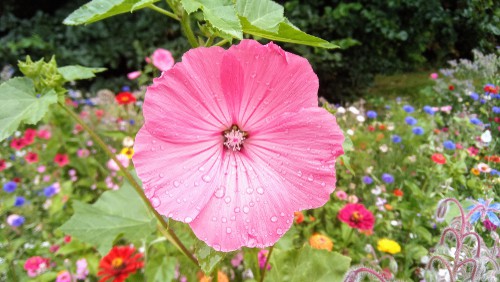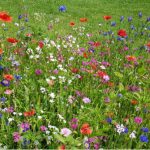Last updated on April 3rd, 2022
Our site is reader supported, this means we may earn a small commission from Amazon and other affiliates when you buy through links on our site.
Wildflower gardens make a wonderful home to flying, winged insects and pollinators, all of whom serve an important ecological purpose. You can create a spectacular wildflower garden with minimal soil preparation. The key is to know ahead of time that wildflowers, while naturally occurring all over the world, are in fact quite fussy about their soil and nutrients. If they do not like the area in which they are growing, they will not perform well. That is why you have to take measures to prepare the ground beforehand.
How to create a wildflower meadow – step by step
Types of Wildflowers
There are two types of wildflowers you can grow:
- Annuals: these germinate, flower, and die all in a single year.
- Perennials/Biannuals: these need a longer period of time to mature, but they live for many years. Perennials continue to grow year after year only dying back for the winter.

Annuals
You need to know the type of seeds you are sowing because they have different soil requirements. Annuals aren’t as fussy and will adapt to most areas because they often thrive in farmland, with a lifecycle that coincides with that of annual farming.
Here are some fun facts about annual wildflowers:
- Wildflowers are often annual which means they grow, flower, seed, and die, all in a single year.
- They often prefer being sown in autumn or in spring.
- They need to be sown into the soil directly, generally by just scattering the seeds over the desired area.
- If germinating from seed (with wildflower seeds) they need a sunny location.
- Wildflowers grow best in full sun with nutrient-rich soil.
- They compete well with things like barley and wheat.
- Most are self-seeding, but you need to distribute the soil to encourage germination.
Preparing the Soil
Once you are ready to prepare your soil, start by choosing a sunny location. The wildflowers you grow will need this sun to thrive.
The area needs to be stripped of all vegetation, especially roots of perennials weeds. The area needs to be dug to a depth of at least 15cm. Remember, the goal here is to copy the same style of preparation as a plough would do on a farm.
The soil should be free draining and aided with organic matter to help it retain moisture. Once that is done, the soil should be raked with a garden rake. You can even consider using a rotavator or tiller to break up and turn the soil.
See our recommended rotavators in this buyer’s guide here
The seeds should be sown right where you want them to flower. They should be thinned according to the packet instructions for the seeds of your choosing. The seeds are often very tiny and mixed with a sand mixture to help spread them more evenly.

Perennials and Biannuals
Perennials and biannuals tend to thrive in low-maintenance areas. They do well when grown amongst grasses too. Perennials tend to flower early in the season, which means that local bees do a lot to pollinate them. They will propagate from seed and then regenerate from the existing roots annually. Realistically, with perennials, the only maintenance you need to do is to cut the flowers in summer (most gardeners with a large swath of land just mow the area). This will go a long way towards a second flush of flowers.
Preparing the Soil
Once you are ready to prepare your soil, start by locating an area with lots of sunlight. Remove all existing vegetation including leaves and roots. It is better to find an area to dedicate to the flowers rather than try to add them near your garden because they thrive in low nutrient soil.
Dig a depth of 12cm on average to loosen up the soil. Lightly fork over the area, especially if you are adding some low nutrient soil on the surface of the trench you have dug.
Put the plants in the ground or spread the wildflower seeds in spring as directed on the seed packet. Cut back the wildflowers and grasses at least once each year, often in late June, to keep soil nutrient content low. This seems counterintuitive, but perennial wildflowers grow in low nutrient areas and your job is to recreate their natural environment.
Popular wildflower seeds to buy
- Attracts Bees and other wildlife to your garden
- Easy to grow
- Seeds and granular compost
- WIDE RANGE OF SEEDS TO GROW; 10 different varieties of perennial flower seeds, 17 different varieties of annual flower seeds and 3 different varieties of biennial flower seeds to grow your own
- GARDENING GIFT OF JOY; The perfect gardening gift for women and gifts for men. Ideal Gardening gift for everyone
- BEES, BUTTERFLIES AND BIRDS; attract all kinds of wildlife and pollinators to your garden
- HIGH QUALITY GERMINATION RATE: All Scott&Co seeds are rigorously tested to ensure high germination rate and are GMO free
- EASY TO SEW AND GROW - With our detailed instructions. All seeds in the seed bag are easy to sow and grow
- Pure Flower Seeds
- Mix of Annual & Perennial species
- Sow at 1-2g per square metre
- Great combination for pollinators
- Gives an ornamental meadow
- Organic British seeds, Our All Perennial is a mix of flowers that once planted and established, come back year after year. Perennials find their home in meadows, garden beds, in combination with annuals and bulbs, and as a dependable accent in both manicured and free-form borders. 50% Annual, 50% Perennial Species; 100% Pure Seed
- Sow 1-2g per square metre.( Please do not sow at more than 2g per square metre)
- Contains many annual and perennial varieties So flowers this year and every year after
- 4 to 8 weeks you will start to see the fruits of your labour
- Soil type Most soils types some sun. Nectar flower seeds mix
- A carefully blended mixture of traditional cottage garden favourites, created to provide a beautiful display of colour throughout the summer months
- Contains flowers that are great for cutting and wll provide a food source for birds and beneficial insects
- Approximately 10 varieties included, covers up to 20 sq. meter. Brings a display of color throughout the summer months
- The RHS Cottage Garden Seed Mix is the perfect blend of traditional favourites for your summer garden.
- Ideal for first-time gardeners, this seed mix covers up to 20m2 and is easy to grow with just three simple steps - shake, rake and awake. Sow in sunny areas for the best results and enjoy beautiful blooms in no time!
Image credits – Shutterstock.com
Last update on 2025-12-14 / Affiliate links / Images from Amazon Product Advertising API







